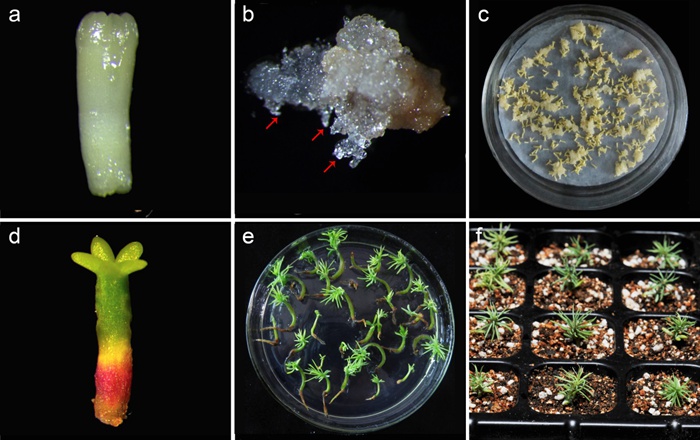
Different germination performance of P. asperata in GCEs and NGCEs. a A GCE after desiccation. b, c GCEs germinated for 9 and 35 days, respectively. d An NGCE after desiccation. e, f NGCEs
germinated for 9 and 35 days, respectively. The figure is representative of at least 20 replicates. (Bars a, d, 500 lm; b, c, e, f, 1 cm)
Abstract
Key message This study provides a novel desiccation indicator for somatic embryos and an efficient system for somatic seedling production in Picea asperata Mast.
Abstract Picea asperata Mast. is a widely distributed native spruce in China with outstanding wood properties and adaptability. In this study, we established an effective system to propagate plantlets through somatic embryogenesis in P. asperata. The effects of cone collection date, seed family, and plant growth regulators on the initiation of embryonal masses (EM) were analyzed. Besides the significant effects of seed family and cone collection date on EM initiation, the highest induction frequency was obtained with modified Litvay medium (MLV) containing 10 lM 2,4-dichlorophenoxyacetic acid and 5 lM 6-benzylaminopurine. The best tissue proliferation in suspension cultures was obtained with an inoculum density of 1:7 (v/v, sedimented cells:liquid medium) after 9 days in culture. The best medium for somatic embryo (SE) maturation was MLV supplemented with 105 lM (±)-abscisic acid, 5% polyethylene glycol 4000, 3% sucrose, 0.1% activated charcoal (AC), 0.05% L-glutamine, 0.1% casein acid hydrolysate, and 0.4% gellan gum. In this medium, 415 ± 103 SEs with well-developed cotyledons were obtained per gram (fresh weight) of EM. After partial desiccation treatment under low light intensity, somatic embryos, depending on their color change, were divided into green cotyledonary embryos (GCEs) and non-green cotyledonary embryos (NGCEs). These embryos, along with non-desiccated SEs as controls, were germinated on 1/2 MLV supplemented with 2% sucrose, 0.2% AC, 0.05% L-glutamine, and 0.6% gellan gum. Only GCEs, with red radicles, produced plantlets at the highest rates ([74.5%) among all of the treatments. This efficient system of somatic seedling production in P. asperata includes screened culture factors and a novel desiccation indicator to ensure SE quality before germination.
Keywords
Spruce Embryonal masses Somatic embryo maturation Somatic embryo germination Partial desiccation Indicator
The paper link:
http://link.springer.com/article/10.1007/s00468-016-1484-4


